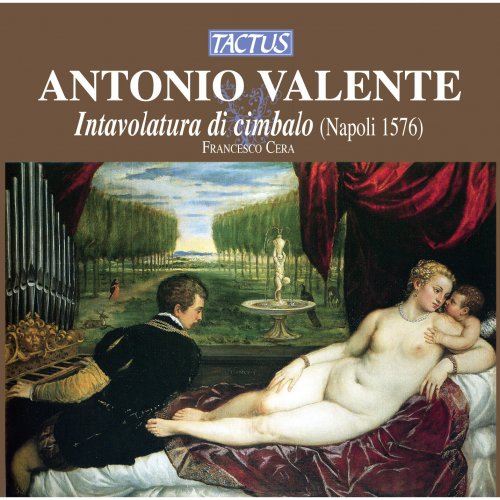
Francesco Cera - Valente: Intavolatura di Cimbalo (Naples 1576) (2012)
BAND/ARTIST: Francesco Cera
- Title: Valente: Intavolatura di Cimbalo (Naples 1576)
- Year Of Release: 2012
- Label: Tactus
- Genre: Classical
- Quality: FLAC (tracks)
- Total Time: 52:38
- Total Size: 313 MB
- WebSite: Album Preview
Tracklist:
1. Intavolatura de cimbalo, Book 1: Gagliarda napolitana (02:04)
2. Intavolatura de cimbalo, Book 1: Romanesca (01:54)
3. Intavolatura de cimbalo, Book 1: Tenore del passo e mezo (03:02)
4. Intavolatura de cimbalo, Book 1: Recercata dell'ottavo tono (03:06)
5. Intavolatura de cimbalo, Book 1: Sortez mes pleurs (03:05)
6. Intavolatura de cimbalo, Book 1: Recercata del septimo tono (03:33)
7. Intavolatura de cimbalo, Book 1: Recercata del primo tono a cinque (06:40)
8. Intavolatura de cimbalo, Book 1: Salve Regina (03:04)
9. Intavolatura de cimbalo, Book 1: Ballo dell'intorcia (01:04)
10. Intavolatura de cimbalo, Book 1: Tenore grande alla napolitana (02:17)
11. Intavolatura de cimbalo, Book 1: Fantasia del primo tono (05:44)
12. Intavolatura de cimbalo, Book 1: Gagliarda e Ballo lombarda (01:13)
13. Intavolatura de cimbalo, Book 1: Bascia flammignia (01:21)
14. Intavolatura de cimbalo, Book 1: Pis ne me peut venir (06:02)
15. Intavolatura de cimbalo, Book 1: Recercata del primo tono (03:47)
16. Intavolatura de cimbalo, Book 1: Recercata del sesto tono (04:36)
1. Intavolatura de cimbalo, Book 1: Gagliarda napolitana (02:04)
2. Intavolatura de cimbalo, Book 1: Romanesca (01:54)
3. Intavolatura de cimbalo, Book 1: Tenore del passo e mezo (03:02)
4. Intavolatura de cimbalo, Book 1: Recercata dell'ottavo tono (03:06)
5. Intavolatura de cimbalo, Book 1: Sortez mes pleurs (03:05)
6. Intavolatura de cimbalo, Book 1: Recercata del septimo tono (03:33)
7. Intavolatura de cimbalo, Book 1: Recercata del primo tono a cinque (06:40)
8. Intavolatura de cimbalo, Book 1: Salve Regina (03:04)
9. Intavolatura de cimbalo, Book 1: Ballo dell'intorcia (01:04)
10. Intavolatura de cimbalo, Book 1: Tenore grande alla napolitana (02:17)
11. Intavolatura de cimbalo, Book 1: Fantasia del primo tono (05:44)
12. Intavolatura de cimbalo, Book 1: Gagliarda e Ballo lombarda (01:13)
13. Intavolatura de cimbalo, Book 1: Bascia flammignia (01:21)
14. Intavolatura de cimbalo, Book 1: Pis ne me peut venir (06:02)
15. Intavolatura de cimbalo, Book 1: Recercata del primo tono (03:47)
16. Intavolatura de cimbalo, Book 1: Recercata del sesto tono (04:36)
The works heard here were published in Naples in 1576 and offer examples of the early genres of keyboard music that emerged at the end of the sixteenth century: dances and variations (which were, one learns, linked in their earliest incarnations by the increasingly energetic movements of a dancer), adaptations of vocal polyphony, and the recercata, an independently conceived polyphonic piece that evolved into the ricercar and later the fugue. The music was designated an intavolatura di cimbalo or intabulation for harpsichord, but performer Francesco Cera plays some of the recercata on a small organ -- probably helpful for the listener in varying the texture and setting them apart from the other selections. Valente, a blind musician, was an organist himself. It might have been nice to see an example of the unique notation Cera explains in his booklet notes -- apparently it consisted entirely of numbers. And it takes a listener really enamored of the idea of searching out the roots of instrumental music to love this stuff; the average buyer may end up like the organist pictured in the Titian painting on the cover, looking over his shoulder at the more interesting nude behind him. Nevertheless, collections strong in Renaissance or early keyboard music should make room for this disc. Cera is an exciting player, with plenty of rhythmic vigor in the dances and a sense of how to evoke the improvisatory roots of the polyphonic pieces without overdoing the freedom. The harpsichord, spinet, and organ used, copies of examples from the middle sixteenth century, are powerful instruments suited to Cera's style, although the harpsichord tends to overemphasize the left-hand accompaniments in the dances. The music heard here contained the keyboard genres of the Baroque in basic but not simple form, and performers like Cera, who give the music a strong physical presence, are bringing it back to life as more than just a page in the history books.
As a ISRA.CLOUD's PREMIUM member you will have the following benefits:
- Unlimited high speed downloads
- Download directly without waiting time
- Unlimited parallel downloads
- Support for download accelerators
- No advertising
- Resume broken downloads


